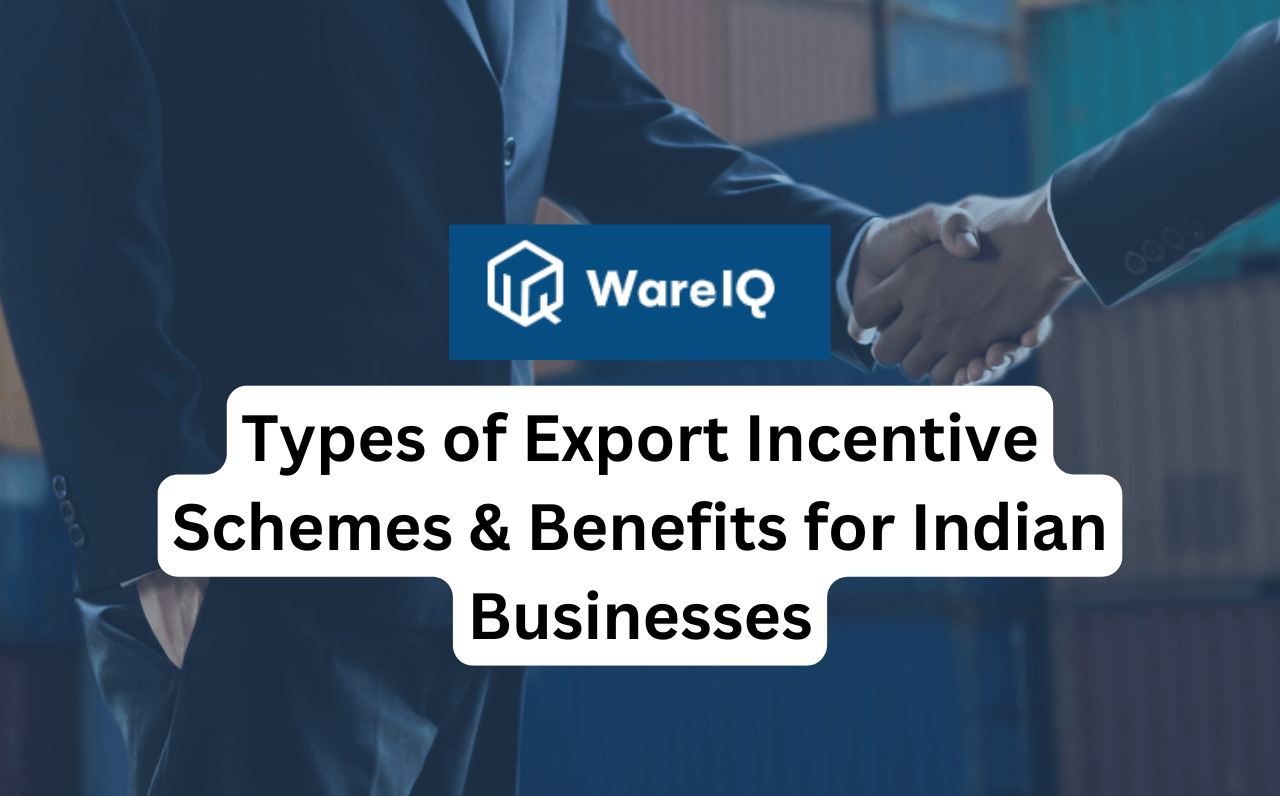Types of Export Incentive Schemes & Benefits for Indian Businesses

Expanding your business into global markets can lead to significant savings on duties and taxes. In 2022, Indian exporters received benefits worth over ₹56,027 crore through various export incentive schemes, supporting a $450 billion export economy. These government-backed schemes are designed to make Indian products more competitive internationally by reducing costs, benefiting everyone from small businesses to large e-commerce companies. They also contribute to India’s goal of reaching $1 trillion in exports by 2025.
However, with several schemes available, choosing the right one can be challenging. This blog provides a comprehensive overview of key export promotion schemes in India, including well-known programmes like RoDTEP and SEIS, as well as lesser-known options such as TMA and MAI. It also addresses common questions like “What are export incentive schemes?” and “How can exporters claim benefits?” Additionally, learn how WareIQ’s logistics solutions can help you maximise these export incentives more efficiently.
- Understanding Export Incentive Schemes
- GST Benefits for Exporters
- Status Holder Scheme
- Deemed Export Benefit Scheme
- Why Export Incentives Are a Game-Changer?
- How to Navigate and Choose the Right Scheme?
- Challenges to Watch Out For
- Skyrocket Your Exports with WareIQ’s Tailored Logistics
- Final Thoughts
- FAQs About Export Incentive Schemes
Understanding Export Incentive Schemes
Export incentive schemes are government initiatives that offer financial and non-financial perks to make Indian exports competitive globally. Managed by the Directorate General of Foreign Trade (DGFT) under the Foreign Trade Policy (FTP) 2023, these schemes provide duty exemptions, tax refunds, and market access support, helping exporters navigate high production costs. With India’s export sector employing millions and contributing 20% to GDP, these export subsidies in India are vital for growth.
RoDTEP Scheme
The Remission of Duties and Taxes on Exported Products (RoDTEP) scheme, effective from January 2021, refunds unrelated taxes like fuel duties for transportation or electricity costs in manufacturing. It replaced the Merchandise Exports from India Scheme (MEIS), disbursing Rs. 12,454 crore in FY 2021-22 via transferable duty credit scrips on ICEGATE.
RoDTEP enhances global price competitiveness and simplifies claims through digital platforms, but exporters must ensure timely export proceeds under FEMA 1999 to avoid penalties. MSMEs and e-commerce exporters in textiles, chemicals, and electronics rely on it for cash flow support.
Advance Authorisation Scheme (AAS)
Advance Authorisation Scheme (AAS) allows duty-free imports of raw materials, fuel, and packaging for export production, exempt from basic customs duty, IGST, and cess (CBIC Notification No. 37/2022-Customs). Exporters must achieve 15% value addition within 18 months, with FTP 2023 easing approvals for apparel.
This scheme cuts production costs, but complex documentation can daunt new exporters. Pharmaceutical, automotive, and food processing firms use AAS to source high-quality inputs.
Export Promotion Capital Goods (EPCG) Scheme
The EPCG scheme permits duty-free imports of capital goods exempt from customs duty, IGST, and cess, with an export obligation of six times the duty saved within six years. FTP 2023’s Post-Export EPCG Duty Credit Scrip adds flexibility for upfront duty payers.
EPCG lowers capital costs, boosting technology adoption, though smaller firms may struggle with export obligations. Textile, telecom, and hospitality sectors leverage it for advanced machinery.
Service Exports from India Scheme (SEIS)
SEIS offers 3-7% duty credit scrips on net foreign exchange earnings for notified services like IT and tourism, requiring an active IEC and $15,000 (Rs 11 lakh) earnings. Scrips are transferable and include credit card payments under FTP 2023.
It offsets marketing costs and simplifies applications but is limited to specific services. IT firms, travel agencies, and construction companies use SEIS to expand globally.
Duty-Free Import Authorisation (DFIA) Scheme
DFIA allows duty-free imports of inputs post-export, covering basic customs duty but not IGST or cess. It requires 20% value addition and is ideal for exporters completing shipments first.
DFIA reduces financial burdens post-export, but its post-export nature delays benefits. Manufacturers in chemicals and engineering use it for flexible sourcing.
Duty Drawback Scheme (DBK)
The Duty Drawback Scheme refunds customs and excise duties on inputs used in exported goods, administered by the Department of Revenue. Rates are set via All Industry Rates or Brand Rates, with claims filed post-export.
It ensures cost recovery, but delays in sale proceeds can reverse benefits. Exporters of garments and electronics benefit from its refund mechanism.
Rebate on State & Central Taxes and Levies (RoSCTL)
Introduced in 2019, RoSCTL refunds taxes like VAT on fuel, mandi tax, and electricity duties for apparel and textile exports (Chapters 61-63 of ITC). It replaced RoSL, extending benefits till March 2024.
RoSCTL boosts textile competitiveness but is sector-specific. Garment and made-up article exporters use it to lower costs.
NIRVIK Scheme
The NIRVIK scheme, launched by the Export Credit Guarantee Corporation (ECGC), offers up to 90% insurance cover on export credit, reducing premiums for small exporters and simplifying claims.
It enhances financial security, but coverage is limited to ECGC-registered exporters. MSMEs and new exporters rely on it for risk mitigation.
Export Oriented Units (EOU) Scheme
The EOU scheme started in 1980 and allows 100% export-focused units to import inputs and capital goods duty-free, with tax waivers and compliance concessions.
EOUs boost production capacity but require full export commitment. Electronics and jewellery manufacturers use it for duty-free operations.
Interest Equalisation Scheme (IES)
IES provides 3-5% interest subsidies on pre- and post-shipment export credit, extended till March 2024. It supports MSMEs and 410 tariff lines governed by the RBI.
It reduces borrowing costs but excludes PLI scheme beneficiaries. Labour-intensive sectors like handicrafts and MSMEs benefit most.
Market Access Initiative (MAI) Scheme
The MAI schema, launched in 2018, funds export promotion activities like market research, trade fairs, and branding in new markets, targeting EPCs and trade bodies.
It expands market reach but benefits larger organisations more. Exporters in emerging sectors like organics use it for global visibility.
Transport and Marketing Assistance (TMA) Scheme
TMA reimburses freight and marketing costs for agricultural exports, effective till March 2021, to make Indian products competitive globally.
It lowers logistics costs but is limited to agriculture. Agri-exporters, especially of spices and fruits, leverage TMA for cost savings.
Duty Entitlement Passbook (DEPB) Scheme
DEPB, now largely phased out, offered post-export credit on FOB value for imports, excluding restricted items like gold. It was discontinued post-2000 for pre-export benefits.
It provided import flexibility, but its phase-out limits relevance. Legacy exporters in engineering used it before RoDTEP.
Learn – How to Get an Export License in India Easily
GST Benefits for Exporters
GST schemes include the LUT Bond Scheme (GST-free exports), IGST refunds, and 0.1% concessional GST for merchant exporters procuring locally.
These reduce tax burdens but require GST registration. E-commerce and merchant exporters benefit from simplified compliance.
Status Holder Scheme
The Status Holder Scheme awards one- to five-star ratings based on export performance, offering privileges like faster customs clearance and bank guarantee exemptions.
It enhances credibility but requires high export volumes. Large exporters in pharmaceuticals and engineering gain the most.
Deemed Export Benefit Scheme
Deemed exports involve goods supplied domestically but paid in foreign exchange, eligible for Advance Authorisation, Duty Drawback, or terminal excise duty refunds.
It supports domestic manufacturers but is situation-specific. Suppliers to SEZs or EOUs use it for tax benefits.
Related – EPCG Scheme: Benefits and Eligibility Explained
Why Export Incentives Are a Game-Changer?
Export incentives aren’t just perks. They are your ticket to global success. With 98% of beneficiaries being MSMEs in 2022, these schemes democratise international trade, helping small businesses shine. Here’s why they’re critical:
- Cost Savings: Duty exemptions and tax refunds slash production and logistics expenses.
- Global Edge: RoDTEP and RoSCTL ensure competitive pricing, boosting exports like India’s $76 billion textiles in 2022.
- Financial Boost: Scrips and insurance via NIRVIK improve liquidity for reinvestment.
- Market Reach: MAI and TMA fund new market entries from Africa to ASEAN.
How to Navigate and Choose the Right Scheme?
Picking the perfect export incentive scheme is like choosing the right tool for a job. Here’s a simple guide for Indian exporters to cut through the clutter:
- Match Your Business Type: Goods exporters (e.g., textiles) should explore RoDTEP, AAS, or RoSCTL; service providers (e.g., IT) go for SEIS. Agri-exporters can tap TMA.
- Identify Cost Pain Points: High input costs? Try AAS or DFIA. Capital-intensive? EPCG is your pick. Need tax refunds? RoDTEP or DBK works best.
- Verify Eligibility: Check requirements like SEIS’s $15,000 earnings or EPCG’s export obligation. MSMEs qualify easily for RoDTEP and NIRVIK.
- Use Digital Platforms: Apply via DGFT’s portal or ICEGATE. Export promotion councils like FIEO offer free guidance on documentation.
- Stack Benefits Wisely: Combine schemes like RoDTEP with EPCG, ensuring no tax refund overlaps. Consult DGFT experts for compliance.
Challenges to Watch Out For
| Scheme | Challenges |
| RoDTEP | Penalties for delayed export proceeds; requires FEMA 1999 compliance. |
| AAS | Complex documentation; 18-month export obligation. |
| EPCG | High export obligation (6x duty saved); tough for small firms. |
| SEIS | Limited to notified services; $15,000 earnings threshold. |
| DFIA | Post-export delays; excludes IGST/cess exemptions. |
| DBK | Reversal if sale proceeds delayed; complex rate fixation. |
| RoSCTL | Textile-specific; limited scope. |
| NIRVIK | ECGC registration required; coverage limits apply. |
| EOU | Full export commitment; high setup costs. |
| IES | Excludes PLI beneficiaries; sector-specific. |
| MAI | Favours larger organisations; indirect benefits for small exporters. |
| TMA | Agriculture-only; expired March 2021. |
| DEPB | Phased out; limited relevance today. |
| GST Benefits | GST registration mandatory; refund delays possible. |
| Status Holder | High export volume needed; benefits skewed toward large exporters. |
| Deemed Exports | Situation-specific; limited to domestic supplies with foreign payment. |
Skyrocket Your Exports with WareIQ’s Tailored Logistics
Leveraging export promotion schemes is only half the battle; efficient logistics seal the deal. WareIQ, a Y Combinator-backed e-commerce fulfilment platform, aligns your export incentives with seamless global delivery, ensuring you maximise every rupee saved.
- Pan-India Fulfilment Network: Access 12+ city hubs for fast delivery across 27,000+ pin codes, syncing with RoDTEP refunds.
- AI-Driven Inventory Management: Inventory LogIQ optimises stock for AAS and EPCG compliance, minimising delays.
- Multi-Channel Integration: Connect with Shopify, Amazon, and Flipkart for streamlined export operations.
- Tech-Enabled Returns Management: Handle returns with HD media evidence supporting RoDTEP and DBK claims.
- Seller Enablement Services: Simplify GST compliance and catalogue listings, boosting export subsidy India benefits.
WareIQ lets you focus on scaling globally while managing logistics with precision, turning export benefits in India into tangible growth.
Final Thoughts
India’s export incentive schemes, from RoDTEP to Status Holder, are powerful catalysts for businesses aiming for global markets. With Rs. 56,027 crore disbursed in 2022, these export promotion schemes in India cut costs, enhance competitiveness, and fuel India’s $1 trillion export dream by 2025. Whether you’re a small e-commerce seller or a large manufacturer, these schemes are your springboard to success. Pair them with WareIQ’s logistics expertise to soar in the $2.7 trillion global trade arena.
Suggested read – A Quick Guide to the EXIM Policy of India and Its Importance
FAQs About Export Incentive Schemes
What are export incentive schemes?
Government programs offering duty exemptions, tax refunds, and subsidies to make Indian exports competitive globally.
What are the tax benefits of export?
Benefits include duty-free imports (AAS, EPCG), tax refunds (RoDTEP, RoSCTL), GST exemptions (LUT Bond), and concessional GST rates (0.1% for merchant exporters).
What is RoDTEP’s scheme in exports?
RoDTEP refunds embedded taxes (e.g., fuel, electricity) via duty credit scrips, effective from January 2021, replacing MEIS.
How to claim export benefits?
Apply via DGFT’s portal or ICEGATE with documents like IEC and export invoices, guided by export promotion councils like FIEO.
What are the benefits of exporting from India?
Exports drive foreign exchange, reduce costs via incentives, expand global reach, and support economic growth, with MSMEs gaining most.








